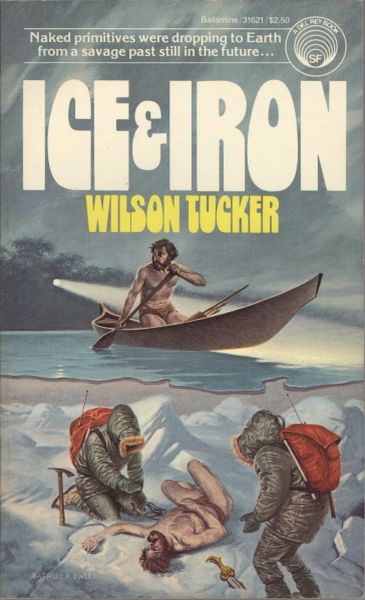It’s Raining Men
Ice and Iron
By Wilson Tucker

22 Oct, 2023
Wilson Tucker’s 1974 Ice and Iron is a stand-alone time travel story.
Earth is cooling. The higher latitudes are becoming increasingly uninhabitable, year by year. In North America, Canada is lost. the northern states of the US cannot be far behind.
Fisher Yann Highsmith’s days are taken up with the investigation of sixteen mysterious corpses.
The dead men have found lying in the snow, seemingly fallen out of the empty sky. They are poorly dressed or even naked; they are certainly not dressed for arctic weather. Such artifacts as are found with them are primitive. To all appearances, the corpses come from an undocumented Stone Age culture.
Corpse Seventeen turns out to be no corpse at all. Seventeen is badly injured but he still clings to life. Whisked away to a hospital, his life is saved, although one arm is not. Seventeen is not talkative and what he does say is unintelligible.
The injured man and his artifacts inspire a wild hypothesis.
There is no Stone Age culture still living in the American north. There was one ages ago, but anyone from that era would have been Native American. Highsmith surmises that the corpses could come from a future when North America is populated by the descendants of modern Americans, descendants who have reverted to Stone Age level technology.
Highsmith does his best to deduce from the available physical evidence what conditions might prevail in the distant future. The climate is interglacial. The reason people and objects fall from the sky is because in the future there is a new Lake Agassiz, whose sea level is meters above the current ground level. The men are badly injured because they are the casualties of a battle. They appear in the present because someone is sending them into the past … somehow.
Oh, and judging from Seventeen’s violent reaction to the first woman he sees, his enemies belong to a matriarchy.
Highsmith will never travel to the future himself to see how accurate his guesses are. The arrivals could verify or contradict his guesses but only Seventeen arrived alive and Seventeen is not inclined to talk. It seems Highsmith will have to settle for informed guesses.
~oOo~
There are, I believe, a number of Science Moves On moments in the novel. For example, one character asserts:
“The available evidence indicates that the world has endured only three ice ages, in the proper sense of the term: the first in late Pre-Cambrian times about six hundred million years ago, the second in early Permian about two hundred and fifty million years ago, and finally the present Pleistocene, which opened about one million years ago.”
I believe those dates are either wrong or have been changed in light of evidence, and at least two more icebox world episodes added.
Nevertheless, Tucker seems to have done a lot of homework for the climate aspect of the book, much of which is featured in the novel.
Remember when many of us believed in the Coming Ice Age? This is a Coming Ice Age story. It’s quite a tragic story, for Canada has perished. The novel is also a Coming War Between Men and Women tale. Remember those? In this instance, the women won.
Readers may have a lot of questions, not least of which is “why would someone dispatch their enemies to the distant past?” Not fully answered. In particular, it is not clear if the people using the time displacement devices know where they are sending their victims. But we do learn more about the peoples of that far future North America. But not a lot. Many of the viewpoint characters are ignorant nomads1 who don’t know much about the world they live in — or its history.
Ice and Iron is a curious novel in many ways. For example, Highsmith does not seem particularly concerned that North America is doomed to barbarism. He merely resolves to move to Mexico, where he is confident that civilization in one form or another will prevail. Thus, any descendants he has will belong to the civilization that will be conquering post-ice age North America.
Also, while the far future scenes outline a particular series of events leading up the cascade of bodies from the sky, they don’t add up to an actual story as such. They are more a sequence of vignettes illuminating the lives of North Americans and the imperialists in the process of conquering North America.
I decided to reread this novel because I hadn’t yet reviewed a Tucker novel and I wanted to do one that was under-reviewed. Other essayists typically cover either The Year of the Quiet Sun or The Long Loud Silence. Sometimes The Lincoln Hunters. Ice and Iron appears to be more obscure.
It would have been a good idea to wonder why this book was so obscure before I read it.
Ice and Iron isn’t a great, forgotten novel. It’s also not a terrible forgotten novel. It’s just a novel with a few nice bits, one that unfortunately does not add up to much. Ah, well. At least it was short.
Ice and Iron is out of print.
1: The North Americans appear to have declined into a Hobbesian war of all against all, a setting in which individuals wander alone for the most part. Men will capture women if they can, but there does not seem to be any social structure as complex as a family. How the nomads manage to maintain their numbers is not at all clear.
